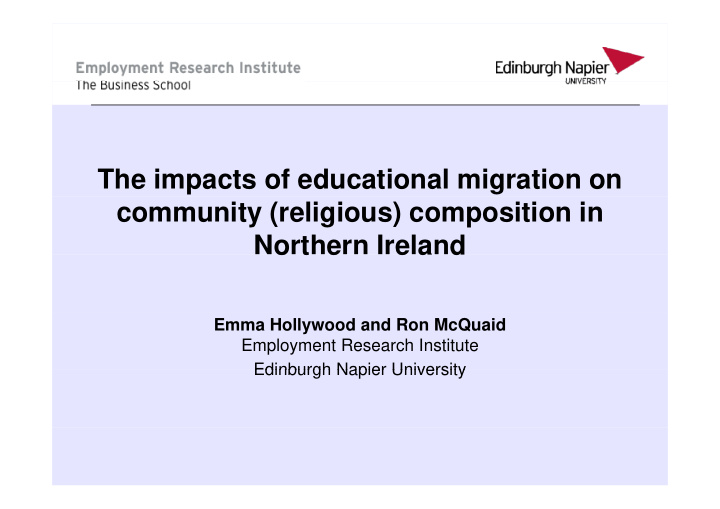



The impacts of educational migration on community (religious) composition in Northern Ireland o t e e a d Emma Hollywood and Ron McQuaid Employment Research Institute Edinburgh Napier University Edinburgh Napier University
Structure � Background to research � Data sources used � Demographic context � Migration in Northern Ireland � Educational migration in NI � Key drivers of educational migration � Implications/conclusions
Background � Funded by the Equality Commission for Northern Ireland � Research was carried out 2007-2008 � Main aim was to examine impacts of educational p migration on community composition in Northern Ireland
Data Sources � UCAS (Universities and Colleges Admissions Service) Admissions Service) � HESA (Higher Education Statistics) � N � Northern Ireland School Leavers Survey th I l d S h l L S � Multiple Deprivation Measures � 2001 Census
Demographic Background � I � Increase in population in the last 30 years i l ti i th l t 30 � Ageing population structure � Predicted decline in 15-24 age group
Community composition of the NI Community composition of the NI population � 53% of population Protestant and 44% Roman Catholic (2001, Census) � The representation of Roman Catholics amongst the Northern Ireland adult population has increased over the period 1990 period 1990 - 2005 (LFS) 2005 (LFS) � The Protestant population has an older age profile than the Roman Catholic population. the Roman Catholic population.
Migration in Northern Ireland � Migration has played an important part in the � Migration has played an important part in the demographic profile of NI � During the 1970s and 1980s, NI experienced g , p consistently large net population loss due to out migration � Recent years have seen population gain through � R t h l ti i th h migration � Continue to lose population through migration in the 15- � Continue to lose population through migration in the 15- 24 age group
Educational migration in NI � One of the key features of HE participation in NI is the out migration of NI students to in NI is the out migration of NI students to GB � During 1970s 40 45% of students were � During 1970s 40-45% of students were recorded as migrants � Those from the protestant community higher � Th f th t t t it hi h tendency to migrate to GB
Destination of NI domiciled students 2005/6 England, 18% Scotland, 11% Wales, 1% Northern Ireland, , 71%
Key drivers of educational migration � Community background � Community background � Social class � S � Social deprivation i l d i ti
Educational attainment by community Educational attainment by community background 2005/6 � Roman Catholic school leavers tend to be better qualified- 47% of Roman Catholics have 2 or more ‘A’ levels on leaving school, compared to 41% of Protestants. � For boys 38% of Roman Catholic school leavers have 2 � For boys, 38% of Roman Catholic school leavers have 2 or more ‘A’ levels compared to 34% of Protestant boys. � 57% of Roman Catholic girls and 49% of Protestant girls � 57% of Roman Catholic girls and 49% of Protestant girls leave school with two or more ‘A’ levels.
Progression to higher education by Progression to higher education by community background, 2005/6 � Progression to Higher Education-Girls 44%; Boys 31% � Boys- Roman Catholic 32.7%; Protestant 27.4% � Girls- Roman Catholics 47.8%; Protestant 40.0% ;
HE destinations by community HE destinations by community background, 2006 90 90 80 70 60 50 % 40 30 20 10 0 P rotestant R om an C atholic O ther 66 77 51 N orthern Ireland 34 34 23 23 49 49 G G B B
Migration and social disadvantage � Strong relationship between social class and migration propensities-those from higher social classes typically more likely to migrate in order to study � There is a general link between the level of deprivation or disadvantage in an area where the student lives and or disadvantage in an area where the student lives and the likelihood of going to HE in NI or GB � NI performs well in term of access to HE for those from � NI performs well in term of access to HE for those from lower socio-economic groups (although still underrepresented)
Educational migration and community Educational migration and community background � Areas with a higher 90% proportion of Roman 80% Catholics have a lower 70% educational out- ath o lic 60% migration rate 50% 50% % R o m an C 40% 30% 20% 10% 0% 0% 0% 5% 5% 10% 10% 15% 15% 20% 20% 25% 25% 30% 30% 35% 35% 40% 40% 45% 45% % Out-migration
The average out migration rate for wards, considering g g g community background populations and levels of deprivation The mean out migration rates 0.4 0.35 0 35 0.3 0.25 0 2 0.2 0.15 0.1 0.05 0 05 0 1 2 3 4 5 Quintiles fo MDM Catholics represent less than 50% of whole population Catholics represent more than 50% of whole population
Implications/conclusions � Research highlighted the importance of community (religion) in understanding educational migration in the NI context � Shows that community background still influences educational migration flows educational migration flows. � Need for more detailed data on religion
Recommend
More recommend